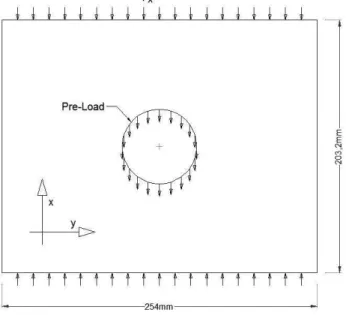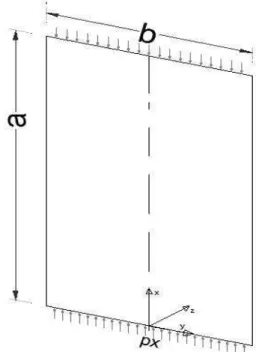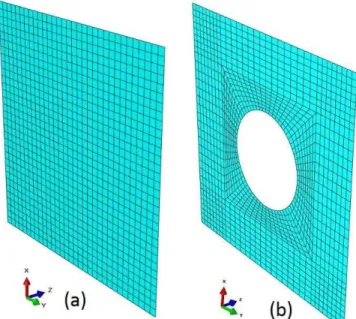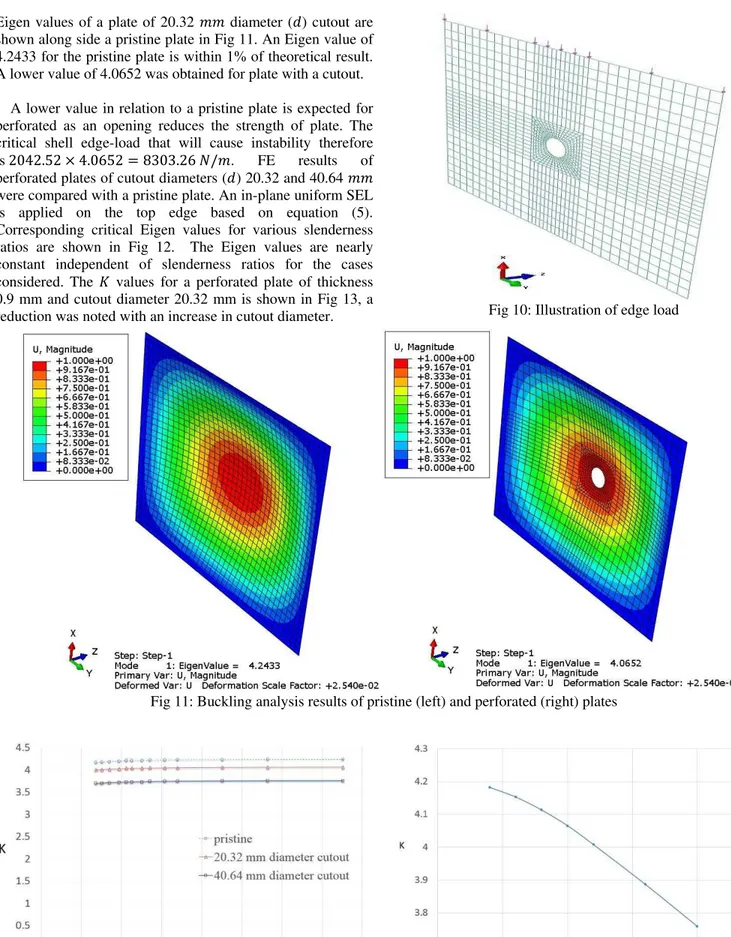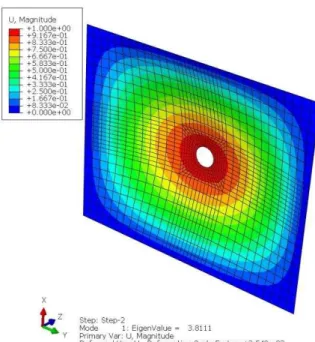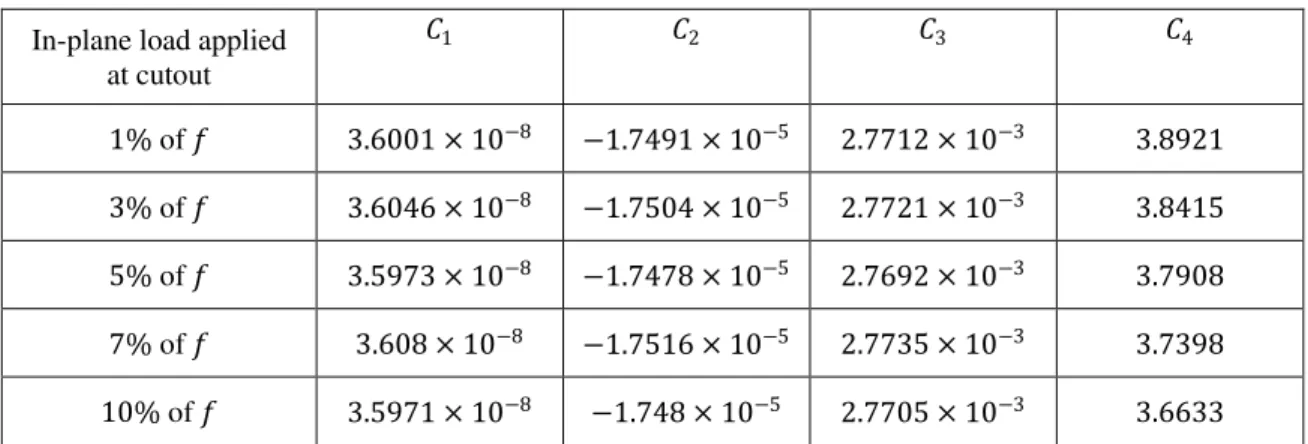Abstract — The stability of perforated plates with an in-plane pre-load at central circular opening were studied. Parametric investigations were conducted by varying the diameter of opening and the magnitude of in-plane force. The effect of aspect ratio (edge-length to thickness) was examined. Three sets of numerical models were prepared. First, the plate structures without any openings (pristine) were simulated for critical buckling loads. Results were verified with theoretical closed form solutions. Second, circular openings were introduced on the same models and simulations were repeated. Finally, all models were simulated with in-plane pre-loads at cutouts. Plots representing Eigen values versus plate slenderness ratio were presented. Critical stresses for stability were calculated in relation to applied in-plane load at cutouts. Finally, a design equation for critical stress values was developed for a perforated plate.
Keywords—Buckling, Perforated plate, ABAQUS, Simply supported, 316L.
Notation:
FE —Finite Element
LPS — Local Positioning System SEL — Shell Edge Load
� — Critical stress for instability
��— Critical stress for instability with pre-load
� — Normal stress parallel to axis
� — Distributed load parallel to axis
� — Elastic Modulus
� — Poisson’s ratio — Thickness of plate
� — Plate buckling coefficient
� — Plate buckling coefficient for a perforated plate — Width of plate
— Length of plate
� — Aspect ratio of plate ( )
� — Slenderness ratio of plate ( ) — Number of Half-waves
� — Critical unit compressive force — Diameter of circular opening
� — Total force applied
� — Applied Shell Edge Load — Multiplication factor
Sathish Nammi, Jean-Luc Mauricette and Hassan Shirvani are with Anglia Ruskin Universitya, Chelmsford, CM1 1SQ, UK (*Corresponding Author Phone: 0845-196-3900; sathish.nammi@anglia.ac.uk). Imran Patel is with University of Hertfordshireb, Hatfield, AL10 9AB.
I. INTRODUCTION
T
he stability of structures is an important area in civil, mechanical, marine, aerospace and many other fields of engineering. Therefore structural stability problems can manifest in a myriad of ways. The field of solid mechanics examines many classic problems on stability criterion, and there is an extensive literature available on fundamental problems in applied mechanics [1], [2]. However, solutions to problems with varying boundary conditions and various possibilities of loads is a challenge, where there are many gaps in knowledge. There are many facets to engineering problems that require further study; one such area is in multi-loading scenerios involving perforated plates. In this paper, a plate without any cutout and with a cutout will be referred to as pristine and perforated.Most published information is largely on pristine plates, whereas perforated plates are still an area requiring further research, especially under complex loading scenerios. Most literature on perforated plates pertain to loads subjected to pure uniaxial, biaxial or shear loading ([3]-[4]). However, problems involving how pre-loads on a centrally located opening affect stability have not been given thorough attention which the current investigations focus upon. The critical load under edge compression is computed for specific dimensions of a perforated plate. Investigations are limited to elastic buckling cases with intention for future research to extend to inelastic problems, with critical instability stresses examined for various slenderness ratios of plates.
II.PROBLEM DESCRIPTION AND JUSTIFICATION OF RESEARCH A schematic of a perforated rectangular perforated plate lateral and longitudinal dimensions of 203.2 × 254 2 and a circular cutout at its centre is shown in Fig 1. Its critical buckling stress diminishes when this plate is subjected to an inplane distributed pre-load on the circular opening. The aim is to develop an equation for critical buckling stress with a known pre-load at its circular cutout. The plate shown in Fig 2 is of a blast resistant enclosure with its front face reinforced with steel and Al foam designed to withstand low yield frontal blast loading. Such reinforcements can be extended to one or more faces depending on the requirements.
Stability of Perforated Plates with an In-plane
Pre-load on Central Cutout
The enclosures have the ability to with-stand high-pressure loads generated in a typical explosion. It is the intention of this research to build enclosures to protect sensor (viz: strain, thermal, LPS and acceleration) and wireless waspnote units. The back face shown in Fig 3 has a circular opening that allows passing wiring harness, and also allows the fixing of several sensors, antennas and media recording equipment, as shown in Fig 4. The back face is pre-loaded due to the mounting of aforementioned units causing the stress distribution to change around the cutouts. In this regard, the work described in this paper will go some way in developing numerical solutions for critical loads for pre-loaded plates.
Fig 1: Problem description
Fig 2: Front and back faces of enclosure
Fig 3: Circular cutout on the back face of enclosure
Fig 4: Illustration of a pre-load to back face III. ANALYTICAL THEORY
An analytical procedures on pristine plate with an edge-compression is presented here in Fig 5 the longitudinal ( ) and lateral ( ) edges are parallel to and axis respectively. This plate is subjected to in-plane edge-load, with a uniformly distributed load acting parallel to the axis given by:
� = � (1) Theoretical critical buckling stress for this case involving uniformly distributed edge compression on two opposite edges, parallel to the axis, is given by [2]:
� =� �2�
12(1−�2) 2
(2)
Here � depends on ratio (�) and number of half-waves ( ) formed in the buckled configuration of plate, and is defined by:
�= �+
� 2
Fig 5: Simply supported pristine plate under pure edge compression
The product of critical stress � and area ( ), which gives the critical unit compressive force, expressed as:
� =� �
2� 12(1−�2)
3
(4)
Buckling will occur in one half-wave shape for short plates with small aspect ratios (�). On or above �= 2, two half-waves will be formed; for a short plate (�< 2), the dependence of parameter � on the aspect ratio is shown in Fig 6. Note that the critical loads for higher values of K are larger than a half-wave mode of buckling. In the current analysis, the aspect ratio of plate investigated is 0.8; hence, only one-half-wave based displacement profile is considered in the analysis. Analytical procedures are tedious for plates with cutouts (perforated), especially, under complex set of boundary conditions and loads, ergo numerical methods are commonly used.
Fig 6: Relationship between � and �
IV. PLATE WITH A PRE-LOAD AT CUTOUT
A perforated plate problem is solved after initial verification of results for a pristine plate. FE models of a pristine plate were compared with theoretical results. An in-plane load on cutout is defined that is equal to product of a multiplication factor ( ) and theoretical critical load of a pristine plate. With this pre-load, the critical edge-load that will cause instability is estimated for a perforated plate.
The critical edge-load that causes buckling is dependent on multiple parameters. Note that the forgoing procedures are quite general involving consideration of just edge-compression. However, at a certain magnitude of pre-load at the cutout, there will be an appreciable depreciation in critical buckling load causing the plate to buckle out of its plane. An illustration of the buckled configuration of plate with one and two-half waves is shown in Fig 7. This phenomenon can be verified experimentally by the observation of lobes. This critical edge-load is smaller for problems with a higher pre-load.
Fig 7: Buckled shapes with (a) one and (b) two-half waves
Fig 8: Illustration of a perforated plate with a pre-load at cutout
Numerical code ABAQUS was used to conduct the investigations with much of the parametric modelling accomplished using PYTHON programming language scripts. FE models with a range of slenderness ratios (40.6 to 225.7) were prepared, with thickness varying between 0.9-5 mm. The dimensions of the rectangular plates used in simulations are detailed in Table I. Yield stress versus plastic strain properties of 316L grade alloy used for FE model is in Table II, an elastic modulus of 200 �� and poisson’s ratio 0.3 were assigned.
Table I: Plate thickness simulated
(mm) (mm) (mm)
0.9 203.2 254 225.7
1.2 203.2 254 169.3
1.5 203.2 254 135.4
2.0 203.2 254 101.6
2.2 203.2 254 92.3
2.5 203.2 254 81.2
2.7 203.2 254 75.2
3.0 203.2 254 67.7
3.2 203.2 254 63.5
3.5 203.2 254 58.0
4.0 203.2 254 50.8
4.5 203.2 254 45.1
5.0 203.2 254 40.6
Table II: Plasticity data for 316L Yield Stress (MPa) Plastic Strain
238.4 0.0
302.8 0.0078
383.9 0.0341
447.9 0.0642
501.6 0.092
594.1 0.146
669.6 0.1998
729.8 0.2516
780.4 0.3035
819.2 0.3559
The material properties were obtained from tensile testing according to EN 10002-1. Note that only elastic properties were considered in this paper. In literature [5] materials are also assumed to deform plastically with no work hardening after yield stress. Such models also referred to as the elastic and perfectly plastic material model. FE models with two cutout diameters of 20.32 and 40.64 were considered. They were descritized into a grid of quadrilateral shell elements using adaptive meshing for modelling curvature around the circular cutouts. A fine mesh was used in zones around the cutout with the best mesh density gained from a grid independence study. High aspect ratios (length to width of elements) in the structured mesh were avoided to minimize inaccuracies illustrated in Fig 9. The general-purpose shell (4-NODE, S4R type ABAQUS [8]) elements that are capable of bending, axial deformation and transverse shear were used. Five integration points were used over the thickness for each element.
Fig 9: Illustration of adaptive mesh (a) pristine (b) with cutout It is assumed that the free edges on the boundary are simply supported in an out-of-plane direction. The bottom end nodes of FE model were constrained against any movement along the global direction. So the boundary conditions reflect a case of simply supported edge condition. An in-plane uniform SEL is applied on the top edge based on the following formulation:
� = �2�
12(1−�2) 3
2 (5)
Eigen values of a plate of 20.32 diameter ( ) cutout are shown along side a pristine plate in Fig11. An Eigen value of 4.2433 for the pristine plate is within 1% of theoretical result. A lower value of 4.0652 was obtained for plate with a cutout.
A lower value in relation to a pristine plate is expected for perforated as an opening reduces the strength of plate. The critical shell edge-load that will cause instability therefore is 2042.52 × 4.0652 = 8303.26 �/ . FE results of perforated plates of cutout diameters ( ) 20.32 and 40.64 were compared with a pristine plate. An in-plane uniform SEL is applied on the top edge based on equation (5). Corresponding critical Eigen values for various slenderness ratios are shown in Fig 12. The Eigen values are nearly constant independent of slenderness ratios for the cases considered. The � values for a perforated plate of thickness 0.9 mm and cutout diameter 20.32 mm is shown in Fig 13, a
reduction was noted with an increase in cutout diameter. Fig 10: Illustration of edge load
Fig 11: Buckling analysis results of pristine (left) and perforated (right) plates
V.EIGEN VALUES UNDER PRE-LOADS AT CUTOUT The FE models previously examined were subjected to additional in-plane pre-loads at cutouts; for example, a theoretical load (� ) of 2180.2 � is obtained from eq. (4) for a 0.9 thick pristine plate. The plate was pre-stressed by a load that is a multiplication factor ( ) of � on nodes around the cutout. The value of was varied between 1 and 10% of
� . i.e. 21.802 and 218.02 N for the aforementioned configuration. An illustration of nodes around the cutout is highlighed in Fig 14. The SEL calculated from eq (5) was applied in the global direction on top edge, and the bottom edge was restrained against moving in the applied direction. Buckling analysis was then carried-out and Eigen values were obtained. An illustration of results for a pre-load of 10% of on 20.32 mm diameter cutout is shown in Fig 15.
Fig 14: Nodes around cutout with in-plane pre-load
Fig 15: FE result for a plate with a pre-load on cutout
VI. RESULTS AND DESIGN EQUATION DEVELOPMENT The elastic stability of a perforated plate with pre-loads at the cutout was examined. A simple, easy to use formula was developed to plot the critical buckling stresses for all configurations of models examined. A buckling coefficient (�) was computed for the perforated plate. A curve fitting exercise was conducted to obtain coefficients through polynomial fits. The general method [5] in the development of design formulae involves a best-fit regression analysis that is a compromise between simplicity and accuracy. Design equations assume slenderness ratio and opening size as the two most important physical variables to affect stability behavior of plates. Generally, the lateral dimensions of the pristine plate are assumed as infinite compared to the diameter of cutout. For square plates ( = ), the buckling or ultimate loads can be considered as:
� = , (6) The same procedure was employed in this paper for cases involving small cutout diameters that are much smaller compared to the dimensions of the plate. A simplified design equation is formulated that is specific to the plate examined. i.e. a 203.2 × 254 2 plate. The objective is to keep the equation simple yet reliable thus less influencial parameters are avoided. This simplified equation considers the slenderness ratio as a function to estimate ��. The critical unit compressive stress at simply supported edges is given by:
�� =� �2�
12(1−�2) 2
(7)
Here � is a function of single independent variable, the slenderness ratio �. It is calculated with a cubic polynomial fit and is given by:
�=�1�3+�
2�2+�3�+�4 (8) The coefficients �1,�2,�3 & �4 are listed in Table III. Note that in this investigation, the maximum in-plane loading at the cutout was limited to 10% of � . The diameter of cutout was kept constant as 40.64 mm. There is a significant reduction in critical buckling load when the pre-load is increased beyond this limit. This is especially true if the diameter of the cutout is increased beyond 20% of edge dimension for a thinner plate. The accuracy of a quadratic fit was not significantly greater than a third order polynomial estimate. This equation will facilitate in the design of enclosures for blast resistant applications.
Table III: List of coefficients for design equation
In-plane load applied at cutout
�1 �2 �3 �4
1% of 3.6001 × 10−8 −1.7491 × 10−5 2.7712 × 10−3 3.8921 3% of 3.6046 × 10−8 −1.7504 × 10−5 2.7721 × 10−3 3.8415 5% of 3.5973 × 10−8 −1.7478 × 10−5 2.7692 × 10−3 3.7908
7% of 3.608 × 10−8 −1.7516 × 10−5 2.7735 × 10−3 3.7398
10% of 3.5971 × 10−8 −1.748 × 10−5 2.7705 × 10−3 3.6633
VII.CONCLUSIONS
Stability of plates containing circular cutouts subjected to in-plane pre-loads at central opening were investigated. A simplified design formula to estimate critical buckling loads was successfully presented. This design equation can be applied to a plate with a cutout diameter 20.32 . It is demonstrated here there is a possibility of developing generic formulae for any diameter cutout. To summarise:
o Both cutout diameter and in-plane pre-load affect the
critical buckling load. However, small in-plane pre-loads on a diameter cutout (less than 10% longer edge length) do not significantly reduce strength.
o The critical stress of instability of a plate always
decreases with increase in slenderness ratio and this decrease is greater for larger diameter (more than 20% of edge ) cutout.
o Increasing the cutout diameter size to 20% of
longitudinal edge , reduces buckling load by 11.4% for a plate of aspect ratio 0.8.
ACKNOWLEDGMENT
This work was also partly supported by the European Commission under RECONASS (FP7-312718), a collaborative project part of the Seventh Framework Programme for research, technological development and demonstration. Furthermore, authors would like to thank all the partners of the consortium for their valuable contribution.
REFERENCES
[1]S.P. Timoshenko and J. M. Gere. Theory of elastic stability (book). Second edition, McGraw-Hill publications, NewYork, 1961.
[2]F. Bleich (1952). Buckling strength of metal structures. McGraw-Hill Book Company, 1995.
[3]D. Ritchie and J. Rhodes. Buckling and post-buckling buckling behavior of plates with holes. Aeronautical Quarterly, November 1975, pp 281-296. [4]K.C. Rockey. The buckling and post-buckling behavior of shear panels
which have a central circular cutout. International conference on thin walled structures, University of Strathclyde, 1979.
[5]N.E. Shanmugam, V. Thevendran and Y.H. Tan. Design formula for axially compressed perforated plates. Thin-Walled Structures 34 (1999) 1-20.
[6]K.M. El-Sawy, A.S. Nazmy and M.I. Martini. Elasto-plastic buckling of perforated plates under uniaxial compression. Thin-Walled Structures 42 (2004) 1083-1101.
[7]P.J. Deolasi and P.K. Datta. Parametric instability characteristics of rectangular plates subjected to localized edge loading (compression or tension). Computers & Structures Vol. 54, No. 1. pp. 73-82, 1995. [8]ABAQUS-Version 6.14 , Abaqus Analysis User’s Manuals, Simulia,
